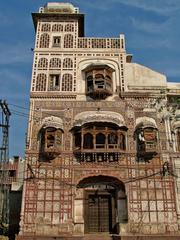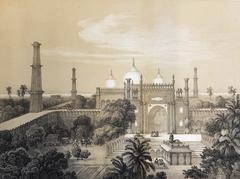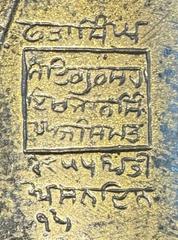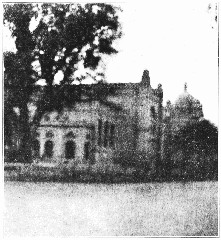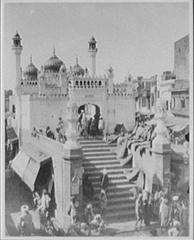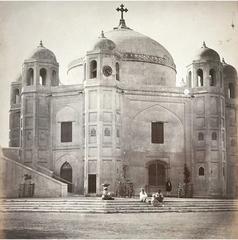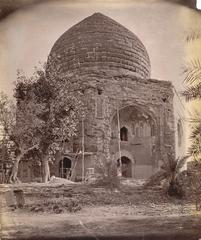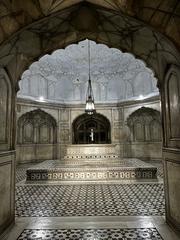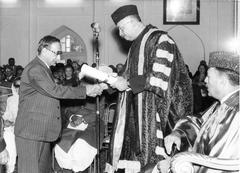Comprehensive Guide to Katra Purbian, Lahore, Pakistan
Publication Date: 18/07/2024
Introduction to Katra Purbian
Table of Contents
- Introduction
- Historical Background of Katas Raj Temples
- Cultural Significance
- Visitor Information
- Nearby Attractions
- Embrace the Serenity of Village Life
- Explore the Natural Beauty
- Visitor Tips
- Special Events and Photographic Spots
- FAQ
- Conclusion
Historical Background of Katas Raj Temples
Ancient Origins and the Mahabharata
The origins of Katas Raj are steeped in legend and mythology, reaching back to the dawn of Hinduism. The site is believed to date back to the era of the Mahabharata, the epic Sanskrit poem that narrates the Kurukshetra War. According to Hindu mythology, the temple complex marks the site where Pandava Yudhishthira, the eldest of the Pandava brothers, outsmarted the Yaksha, a nature spirit, in a battle of wits. This victory is said to have brought forth a spring, the sacred Katas Raj pond, from the tears of Shiva, the Hindu god of destruction, who mourned the death of his wife Sati.
A Flourishing Center of Hinduism
Over the centuries, Katas Raj evolved into a prominent center of Hindu pilgrimage. The complex witnessed the rise and fall of various dynasties, each leaving their mark on its architecture and legacy. The Huna rulers, who controlled much of Central and South Asia in the 5th and 6th centuries CE, are believed to have been patrons of the temples. Their reign saw the construction of several significant structures, contributing to the complex’s growing religious significance.
The Arrival of Islam and a Shifting Landscape
The arrival of Islam in the Indian subcontinent during the 7th century CE brought about a significant shift in the region’s religious landscape. While the Katas Raj Temples continued to hold importance for the Hindu community, their prominence gradually declined. Despite the changing times, the site remained a place of pilgrimage for Hindus, albeit on a smaller scale.
Mughal Patronage and a Period of Relative Harmony
During the Mughal era, which spanned from the 16th to the 19th centuries, the Katas Raj Temples experienced a period of relative peace and even received some patronage from the Mughal rulers. The Mughal emperor Akbar, known for his religious tolerance, is said to have granted the site to the local Hindu community. This era saw the temples relatively well-maintained, a testament to the Mughal Empire’s policy of religious coexistence.
Colonial Rule and Renewed Interest
The arrival of the British in the 19th century brought about renewed interest in the Katas Raj Temples, albeit from an archaeological and historical perspective. British scholars and officials documented the site, recognizing its historical and cultural significance. Their efforts helped bring Katas Raj to the attention of a wider audience, sparking curiosity about its ancient past.
Post-Independence and the Present Day
Following Pakistan’s independence in 1947, the Katas Raj Temples faced a period of neglect. However, in recent years, there has been a renewed effort to preserve and restore this historical and religious treasure. The government of Pakistan has undertaken restoration projects, recognizing the site’s importance as a symbol of the country’s diverse heritage.
Cultural Significance
Hinduism - A Site of Pilgrimage and Legend
For Hindus, Katas Raj holds immense religious importance. The temple complex is considered one of the oldest and most sacred sites in Hinduism, believed to have been visited by the Pandava brothers during their exile as mentioned in the epic Mahabharata. The most significant legend associated with Katas Raj revolves around the mourning of Lord Shiva over the death of his beloved wife, Sati. Legend has it that Shiva’s tears at this location formed the sacred pond, Katas, considered holy by Hindus. Pilgrims from across the globe, particularly during the annual Katas Raj festival, visit the site to bathe in the sacred pond, believing it to cleanse them of their sins.
Sikhism - A Revered Guru’s Footprint
Katas Raj also holds a special place in Sikhism. The complex houses a gurdwara, a place of worship for Sikhs, marking the visit of Guru Nanak, the founder of Sikhism, in the 16th century. His visit is said to have brought peace to the region, further solidifying the site’s sanctity.
Buddhism - Echoes of an Ancient Past
While the existing structures primarily reflect Hindu and Sikh traditions, Katas Raj also bears traces of its Buddhist past. Historical records and archaeological evidence suggest the presence of a Buddhist stupa and monastery within the complex during the reign of Ashoka the Great in the 3rd century BCE. This highlights the site’s historical role as a confluence of various religious practices and beliefs.
A Symbol of Shared Heritage and Interfaith Harmony
Beyond its religious significance, Katas Raj stands as a powerful symbol of Pakistan’s diverse cultural heritage and interfaith harmony. The site’s history, spanning millennia and encompassing multiple religions, reflects the region’s long tradition of religious tolerance and coexistence. The presence of a functioning mosque within the complex further emphasizes this spirit of inclusivity. It serves as a testament to the peaceful coexistence of different faiths that has characterized the region for centuries.
Visitor Information
Visiting Hours
The Katas Raj Temples are open to visitors daily from 8:00 AM to 6:00 PM. It is advisable to check for any changes in visiting hours during public holidays or special events.
Tickets
There is no entry fee for the Katas Raj Temples, making it accessible to all visitors. However, donations are welcomed and go towards the preservation of the site.
Travel Tips
- Best Time to Visit: The ideal time to visit Katas Raj Temples is during the cooler months from October to March.
- Guided Tours: Consider joining a guided tour to gain deeper insights into the site’s history and significance.
- Photography: The temples offer numerous photographic spots, particularly around the sacred pond and intricate temple carvings.
- Nearby Attractions: Visitors can also explore nearby historical sites such as the Khewra Salt Mine and the Rohtas Fort.
Nearby Attractions
Kallar Kahar
A picturesque lake and tourist spot about 24 kilometers from Katas Raj.
Salt Range
Ideal for hiking and exploring the unique geological features of the region.
Malot Fort
Another historical site located within the Salt Range, offering panoramic views.
Embrace the Serenity of Village Life
Interact with Locals
Katra Purbian offers a glimpse into the authentic rural life of Punjab. Engage with the friendly locals, experience their hospitality, and learn about their daily lives, traditions, and agricultural practices.
Explore the Countryside
Take a leisurely stroll or bike ride through the village and its surrounding areas. The lush green fields, picturesque landscapes, and fresh air provide a welcome escape from the hustle and bustle of city life.
Discover Hidden Gems
Ancient Mosque
Katra Purbian is home to an old mosque, a testament to the village’s historical and cultural heritage. While little information might be readily available, inquire with locals about its history and significance. They often hold valuable insights passed down through generations.
Local Shrines
Like many villages in Punjab, Katra Purbian likely has local shrines revered by the community. These shrines often have unique stories and traditions associated with them. Approach these sites with respect and curiosity, and you might be privy to fascinating local lore.
Explore the Natural Beauty
Kallar Kahar Lake
Just a short distance from Katra Purbian lies the scenic Kallar Kahar Lake, a saltwater lake known for its beauty and diverse birdlife. Enjoy a picnic by the lake, take a boat ride, or simply soak in the tranquility of the surroundings.
Takht-e-Babri
Hike up to Takht-e-Babri, a nearby hilltop offering panoramic views of the lake, the surrounding Salt Range, and the vast plains below. This historical spot is believed to have been visited by the Mughal Emperor Babur.
Visitor Tips
Best Time to Visit
The best time to visit Katra Purbian and its surrounding areas is during the cooler months, from October to March, when the weather is pleasant for outdoor activities.
Transportation
While local transportation might be available, it’s advisable to have your own vehicle for convenient travel within and around Katra Purbian.
Accommodation
Katra Purbian itself might have limited accommodation options. Consider staying in nearby towns like Chakwal or Kallar Kahar, which offer a range of hotels and guesthouses.
Respect Local Customs
As with visiting any rural community, dress modestly and be mindful of local customs and traditions. Seek permission before taking photographs of people or religious sites.
Food and Drink
While restaurants might be limited in Katra Purbian, you can find local eateries in nearby towns serving traditional Pakistani cuisine. Be sure to try the local specialties.
Safety
Katra Purbian is generally a safe area, but it’s always advisable to take necessary precautions and be aware of your surroundings.
Connectivity
Mobile network coverage is generally good in the area.
Special Events and Photographic Spots
Festivals
The site hosts various Hindu festivals, including Maha Shivaratri and Diwali, attracting pilgrims from across the country.
Photographic Spots
The Katas Raj pond and the intricate carvings on the temple walls make for stunning photography.
FAQ
Q: What are the Katas Raj Temples known for?
A: The Katas Raj Temples are known for their historical significance, intricate architecture, and the sacred Katas Raj pond.
Q: Is there an entry fee for the Katas Raj Temples?
A: Entry is free, but donations for maintenance are appreciated.
Q: What is the best time to visit the Katas Raj Temples?
A: The best time to visit is during the cooler months from October to March.
Q: Are there guided tours available at Katas Raj Temples?
A: Yes, guided tours are available and are highly recommended for a more informative visit.
Q: What are some nearby attractions?
A: Nearby attractions include Kallar Kahar, the Salt Range, and Malot Fort.
